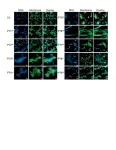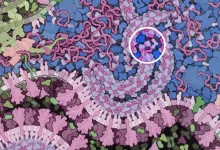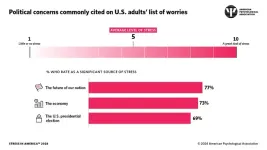(Press-News.org) Researchers have discovered a new group of bacterial toxins that can kill harmful bacteria and fungi, opening the door to potential new treatments for infections. These toxins, found in over 100,000 microbial genomes, can destroy the cells of bacteria and fungi without harming other organisms. The study revealed how some bacteria use these toxins to compete with other microbes, and the findings could lead to new ways to fight infections, especially as antibiotic resistance becomes a growing concern.
A new study, published in Nature Microbiology, led by Hebrew University researchers Dr. Asaf Levy from the Institute of Environmental Science, Dr. Neta Schlezinger from the Koret School of Veterinary Medicine and Dr. Netanel Tzarum from the Institute of Life Sciences in collaboration with Weizmann Institute of Science researchers Profs. Jacob Klein and Meital Oren-Suissa, and with Prof. Herbert Schmidt from University of Hohenheim, has revealed a new arsenal of bacterial toxins with the potential to fight infectious human and plant diseases. These toxins, which are encoded in the genomes of certain bacteria, exhibit potent antibacterial and antifungal properties, offering exciting new possibilities for clinical and biotechnological applications.
Microbial competition is a natural phenomenon, and bacteria have evolved sophisticated methods, including toxins, to eliminate competitors. The most famous examples of natural compounds used in competition in nature are antibiotics produced by bacteria and fungi.
In this study, Dr. Levy’s team developed an innovative computational approach to identify previously undiscovered toxin protein domains, which are 100-150 amino acid long, within over 105,000 microbial genomes. These protein toxins, referred to as polymorphic toxins, play a crucial role in microbial warfare, targeting and killing competing microorganisms in different ecosystems.
The research team, students and postdoctoral fellows: Nimrod Nachmias, Noam Dotan, and Dr. Marina Campos Rocha, and staff scientists Dr. Yaara Oppenheimer-Shaanan and Rina Fraenkel, successfully validated nine newly discovered toxins, each representing a large evolutionary conserved family, demonstrating their ability to cause cell death in both Escherichia coli and Saccharomyces cerevisiae when expressed in these model organisms. Of particular note, five antitoxin genes, also known as immunity genes, were also identified, which protect the bacteria producing the toxins from self-destruction.
Interesting to note that the toxins exhibit powerful antifungal activity against a range of pathogenic fungi, while leaving certain invertebrate species and macrophages unaffected. The study’s experimental results suggest that these toxins primarily act as efficient enzymes that target essential cellular processes, such as the cell membrane, DNA, or cell division. Structural analysis of two toxin-immunity protein complexes further confirmed that some of these toxins possess DNase activity, which can degrade DNA in target cells. Interestingly, the structure show that the toxin is positively charged in its DNA binding site, to bind the negatively charged DNA, whereas the antitoxin protein is negatively charged to prevent the toxin from binding to the target DNA.
“Our findings expand our understanding of how bacteria use toxins in competition with other microbes and provide exciting avenues for future research into critically needed antimicrobial agents against human and plant bacterial and fungal pathogens,” said Dr. Levy. “The potential for these toxins to serve as a foundation for new clinical treatments or biotechnological innovations is particularly exciting.”
This research not only enhances the knowledge of microbial toxins but also sheds light on their potential therapeutic use. The team’s discovery could pave the way for novel antimicrobial strategies, particularly as the world grapples with the rise of antibiotic-resistant pathogens.
The study has broad implications for both the understanding of microbial interactions in different environments and the development of next-generation antimicrobials. By revealing the mechanisms through which these toxins operate, the research offers hope for new treatments in the ongoing fight against bacterial and fungal infections.
END
New bacterial toxins discovered: A key to fighting infections
2024-10-22
ELSE PRESS RELEASES FROM THIS DATE:
AI eye to eye with ophthalmologists in diagnosing corneal infections, study finds
2024-10-22
Eye care specialists could see artificial intelligence help in diagnosing infectious keratitis (IK), a leading cause of corneal blindness worldwide, as a new study finds that deep learning models showed similar levels of accuracy in identifying infection.
In a meta-analysis study published in eClinicalMedicine, Dr Darren Ting from the University of Birmingham conducted a review with a global team of researchers analysing 35 studies that utilised Deep Learning (DL) models to diagnose infectious keratitis.
AI models ...
Virginia Tech researcher works to preserve the white shark in the Mediterranean Sea
2024-10-22
The Mediterranean Sea is a paradise.
Pristine waters and an incredible coastline spanning multiple continents that are renowned the world over.
Below those picturesque, and sometimes crowded, waters swim a legendary creature facing a treacherous and uncertain future: the white shark.
Francesco Ferretti, an assistant professor in the College of Natural Resources and Environment, is working to save one of the most endangered white shark populations on the planet. The research team located signs of the remaining white sharks ...
How the coronavirus defeats the innate immune response
2024-10-22
The novel coronavirus SARS-CoV-2 has an enzyme that can counteract a cell’s innate defense mechanism against viruses, explaining why it is more infectious than the previous SARS and MERS-causing viruses. The Kobe University discovery may point the way to the development of more effective drugs against this and possibly similar, future diseases.
When a virus attacks, the body’s immune response has two basic layers of defense: the innate and the adaptive immune systems. While the adaptive immune system grows stronger against a specific pathogen as the body ...
APA Poll: Future of nation, economy and presidential election top U.S. stressors
2024-10-22
WASHINGTON — More than 7 in 10 adults said the future of the nation (77%) is a significant source of stress in their lives, with the economy (73%) and the 2024 U.S. presidential election (69%) following closely behind, according to the latest Stress in America™ survey released today by the American Psychological Association.
At the same time, the poll found many common stressors among people with different political party affiliations. The survey was conducted by The Harris Poll on behalf of APA among more ...
Towards better solar cells: Exploring an anomalous phenomenon of electricity generation
2024-10-22
The bulk photovoltaic (BPV) effect is an uncommon phenomenon that may enable certain materials to outperform the conventional p–n junctions used in solar cells. In a recent study, researchers from Japan have experimentally demonstrated the BPV effect in alpha-phase indium selenide (α-In2Se3) for the first time along the out-of-plane direction, validating previous theoretical predictions. The remarkable conversion efficiency recorded in their α-In2Se3 device signals a promising advancement for future solar cell technologies and photosensors.
A firm understanding ...
KERI’s innovation in anode materials for solid-state batteries selected as a cover article
2024-10-22
The KERI's research on anode materials for solid-state batteries (SSBs), conducted in collaboration with Kumoh National Institute of Technology and Inha University, has been selected as the cover article of a world-leading journal in the energy field.
The SSBs have replaced the combustible liquid electrolyte that transfers ions between the anode and cathode with a solid electrolyte, significantly reducing the risk of fire or explosion. However, SSBs, due to their 'solid' nature, require much advanced technology, such as ensuring electro-chemo-mechanical stability during the charging and discharging processes. In particular, since the anode has a ...
A visit from the stork brings genomic hope for this endangered species
2024-10-22
A Visit from the Stork Brings Genomic Hope for this Endangered Species
A new genomic study of the endangered Oriental Stork reveals that the population's genetic health is still surprisingly strong, with high genetic diversity and low levels of inbreeding. This is an uncommon finding in most endangered species populations, which makes it more difficult to rescue those species from extinction. Thus, despite the human-caused decline in the Oriental stork numbers, the findings in this study provide hope for the species' long-term ...
Study uncovers the true burden of asthma in African pupils, highlighting need for better access to asthma diagnosis and care
2024-10-21
Peer reviewed | Observational study | People
Rapid urbanisation and population growth in sub-Saharan Africa has increased the incidence of asthma in young people, but the lack of diagnosis and care means that many young people are suffering from untreated symptoms of asthma, according to research from Queen Mary University of London.
The team who led the study, whose pioneering research on the impact of pollution on lung health was instrumental in introducing the Ultra Low-Emission Zone (ULEZ) in London, are calling for better access to asthma diagnosis and care in areas of ...
A remote-controlled car for cancer immunotherapy
2024-10-21
OCTOBER 21, 2024, NEW YORK – Ludwig Cancer Research scientists have devised new types of chimeric antigen-receptor (CAR) T cells—a type of cancer immunotherapy—that can be switched on to varying degrees of intensity and then switched off on demand with existing drugs. The design and preclinical evaluation of the CAR-T cells, led by Melita Irving and Greta Maria Paola Giordano Attianese of the Lausanne Branch of the Ludwig Institute for Cancer Research, is detailed in this week’s issue of the Proceedings of the National Academy of Sciences.
“CAR-T cells are already used today to treat a number of blood cancers, but ...
New ice core data provides insight into climate ‘tipping points’ during the last Ice Age
2024-10-21
CORVALLIS, Ore. – A changing climate triggers a sudden shift in ocean circulation, creating weather havoc and plunging Earth into an abrupt new Ice Age.
It sounds like the basis for a Hollywood blockbuster - the 2004 science fiction disaster film “The Day After Tomorrow,” has similar plot lines – but it’s actually a scenario that played out multiple times during the last Ice Age, which ended more than 11,000 years ago.
Just published research from multiple ice cores collected across Greenland with data spanning up to 120,000 years provides new understanding of these abrupt events, how they unfold and what that might ...







